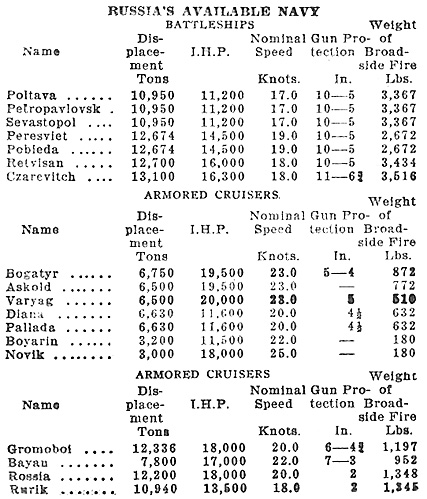 The naval strength of Russia in the Far East at the outbreak of hostilities is shown in the tabular statement, which, again, does not include vessels of the smallest class nor the torpedo-boat flotilla.
The naval strength of Russia in the Far East at the outbreak of hostilities is shown in the tabular statement, which, again, does not include vessels of the smallest class nor the torpedo-boat flotilla.
It will be remarked that the Russian battleships offered a great variety in design and fighting power -- a serious disadvantage, for in manoeuvring the efficiency of the whole squadron sinks to the level of that of the least effective vessel it contains.
The Czarevitch and the Retvisan, which were the latest vessels to arrive at Port Arthur, were also the most powerful members of the fleet. The former vessel was built in France after the latest French model, and the latter in Philadelphia. This fleet was divided, at the outbreak of war, between Port Arthur and Vladivostock, the four powerful cruisers, Gromoboi, Bogatyr, Rossia, and Rurik being stationed at the latter port.
Re-inforcements
While negotiations were still proceeding, though at a critical point, Russia prepared to send out very formidable reinforcements to the Far East from her Mediterranean Fleet. These reinforcements included the Osliabia, a battleship of over 12,000 tons displacement, with a speed of ig knots; the Dmitri Donskoi, an armored cruiser of 6,000 tons displacement and a speed of 15 knots; the Aurora, a swift protected cruiser of the largest class; several cruisers of the volunteer fleet, with troops, naval drafts, and supplies; and a number of torpedo craft.
This squadron had begun to assemble at Port Said before the outbreak of war, and the vessels at once began to pass through the Canal. But before they were ready to sail for the China seas, war broke out, and the departure was delayed. The initial Russian reverses at sea made it practically impossible for this reinforcing fleet to proceed to the seat of war, as it would have been liable to interception by the Japanese fleet in overwhelming strength. Accordingly, after cruising aimlessly about in the Red Sea for some weeks, the ships were ordered to return to the Baltic; and in the beginning of March they passed through the Suez Canal again on their way north.
Back to Table of Contents -- The Russo-Japan War # 2
Back to The Russo-Japan War List of Issues
Back to MagWeb Master Magazine List
© Copyright 2005 by Coalition Web, Inc.
This article appears in MagWeb.com (Magazine Web) on the Internet World Wide Web. Other articles from military history and related magazines are available at http://www.magweb.com
